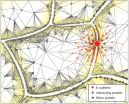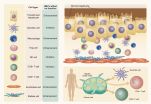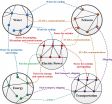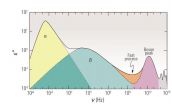Mapping the interactome
Proteomics reveals the E-cadherin interaction network
2014-12-03
(Press-News.org) Researchers at the Mechanobiology Institute at the National University of Singapore have comprehensively described the network of proteins involved in cell-cell adhesions, or the cadherin interactome. This work was published in Science Signaling (Guo et al. E-cadherin interactome complexity and robustness resolved by quantitative proteomics, Science Signaling, 02 Dec 2014, Vol 7, Issue 354).
Unlocking the complexity of cell adhesion
Many biological processes depend on the ability of cells to stick to one another. The formation of multicellular organisms and precise embryonic development rely on this property, as does the maintenance of healthy tissue. Defects in the ability of cells to adhere to one another have been found in many diseases, such as cancer, Alzheimer's disease and cardiovascular disease. In the case of cancer, ineffective cell adhesion allows tumour cells to detach and invade other tissues, thereby spreading cancer throughout the body.
Cell-cell adhesion is made possible through various cellular structures that are collectively known as cell-cell adhesion complexes. The most prominent cell-cell adhesion complex is the Adherens Junction. Central to adherens junctions is a protein known as E-cadherin, or epithelial cadherin. E-cadherin spans the cell membrane, providing a link between the interior, and exterior of the cell. Outside the cell, E-cadherin binds to other E-cadherins from neighbouring cells in a mechanism that can be described as a 'cellular handshake'. On the inside of the cell, E-cadherin binds to linker proteins known as catenins, which attach to a structural scaffold that lies adjacent to the adhesion site, the actin cytoskeleton. This physical link between the cytoskeletons of neighboring cells allows for the generation and transduction of mechanical signals.
Despite their importance in cell-cell adhesion, scientists have yet to fully understand how the cadherin-catenin-actin complex forms and is regulated. To extend the idea of cell adhesion being like a 'cellular handshake', imagine walking along a crowded street while holding hands with a partner. Moving together with the flow of people, navigating obstacles, adjusting your speed and responding to changes in conditions must all be considered if you are to reach your destination without letting go. Similarly, cells must maintain their adhesion while facing varying stresses and biochemical conditions. Hence, the adhesive structures are regulated and adjusted, via a complex network of structural and regulatory proteins. Where defective adhesion has led to a certain disease it is essential to understand where the problem lies and this requires stepping back and looking at the whole picture.
To better identify the components of this wider network in maintaining and regulating adhesion, researchers at the Mechanobiology Institute, National University of Singapore, applied a combination of experimental and computational techniques to reveal and dissect the complex network of proteins that interact with E-cadherin. To achieve this, E-cadherin was labelled with an enzyme that, when activated, releases a small cloud of a tagging molecule to flag all other proteins in the immediate vicinity. When coupled with quantitative proteomics, this provides a list of proteins interacting with E-cadherin, thus capturing many of the proteins that influence the adhesive properties of the cell.
Overall 561 proteins were found to be associated with E-cadherin, and remarkably 419 of these interactions were completely novel. Using a protein interaction database, the researchers created a map of the E-cadherin interactome that contains information on the function of each protein and its interactions with other proteins within the network. The majority of proteins found were identified as adaptor proteins, which serve as scaffolds within the Adherens Junction. Other proteins involved in cellular transport and protein synthesis were also identified. Interestingly, the researchers found that most of the proteins that associated with E-cadherin did so independently of cell-cell adhesion.
This study highlights that cell adhesion results not only from the formation of a cadherin-catenin-actin complex, but from the activity of more than 500 interacting proteins. Successful cell adhesion requires a cascade of events involving these proteins and any breakdown in this cascade could lead to impaired cell adhesion, and disease. With the E-cadherin interactome now described in detail, researchers can finally step back and view the complex picture that is cell-cell adhesion. This will allow disease related defects to be identified, and new targets researched to understand this vital biological process.
INFORMATION:
[Attachments] See images for this press release:

ELSE PRESS RELEASES FROM THIS DATE:
2014-12-03
Plastic is well-known for sticking around in the environment for years without breaking down, contributing significantly to litter and landfills. But scientists have now discovered that bacteria from the guts of a worm known to munch on food packaging can degrade polyethylene, the most common plastic. Reported in the ACS journal Environmental Science & Technology, the finding could lead to new ways to help get rid of the otherwise persistent waste, the scientists say.
Jun Yang and colleagues point out that the global plastics industry churns out about 140 million tons ...
2014-12-03
Hepatocellular carcinoma (HCC) is one of the few cancers in which a continued increase in incidence has been observed over recent years. Globally, there are approximately 750,000 new cases of liver cancer reported each year. Importantly, population-based studies show that HCC ranks as the third leading cause of cancer-related deaths worldwide. Also, a large proportion of HCC patients display symptoms of intrahepatic metastases or postsurgical recurrence, with a five-year survival rate of around only 30-40%.
Among the various pathogenic factors, HBV infection accounts ...
2014-12-03
Current asthma treatments can alleviate wheezing, coughing and other symptoms felt by millions of Americans every year, but they don't get to the root cause of the condition. Now, for the first time, scientists are reporting a new approach to defeating asthma by targeting the trigger -- the allergen -- before it can spark an attack. They describe their new compound, which they tested on rats, in ACS' Journal of Medicinal Chemistry.
Clive Robinson and colleagues explain that to prevent many health problems, the ideal approach to treatment or prevention involves getting ...
2014-12-03
The interdisciplinary field of network science has attracted enormous attention in the past 10 years, although most results have been obtained by analyzing isolated networks. However many real-world networks interact with and depend on other networks.
"The properties and dynamics of interdependent and interconnected networks have been studied extensively, and scientists are finding many interesting results and discovering many surprising phenomena," state scientists based in China, the US and Israel who co-authored a new study, "From a single network to a network of ...
2014-12-03
Humans have been experimenting with and utilizing glassy materials for more than ten millennia, dating back to about 12000 B.C. Although glassy materials are the oldest known artificial materials, new discoveries and novel applications continue to appear.
Yet understanding of glass is far from complete, and the nature of glass constitutes a longstanding puzzle in condensed mater physics.
In a new overview titled "The β-Relaxation in Metallic Glasses" and published in the Beijing-based National Science Review, co-authors Hai Bin Yu and and Konrad Samwer, based at ...
2014-12-03
In order to observe the impact of climate change on soil microorganisms under as natural conditions as possible, the scientists transferred intact young beech seedlings from a cool, wet, northwest-exposed site of a slope approximately corresponding to present climatic conditions to a warmer site exposed to the southwest. This transfer simulated temperature and precipitation profiles as can be expected from climate change. "We tried to keep initial soil type and nutrient content sin soil as comparable as possible to avoid additional factors influencing our data"," said Prof. ...
2014-12-03
With good planning, it is possible to promote the reuse of construction and demolition waste and thereby both conserve the environment and save on material costs. In the future, it will be even more important to assess how buildings can reasonably be repaired or demolished into parts, together with how the remaining service life of the parts can be utilized in new applications. The best method is to implement demolition planning already as a component of construction design.
Reuse of construction parts is always worthwhile from the perspective of the environment, and ...
2014-12-03
For years, scientists have been pursuing "artificial leaf" technology, a green approach to making hydrogen fuel that copies plants' ability to convert sunlight into a form of energy they can use. Now, one team reports progress toward a stand-alone system that lends itself to large-scale, low-cost production. They describe their nanowire mesh design in the journal ACS Nano.
Peidong Yang, Bin Liu and colleagues note that harnessing sunlight to split water and harvest hydrogen is one of the most intriguing ways to achieve clean energy. Automakers have started introducing ...
2014-12-03
Their novel findings obtained by measuring "cortical thickness" for the first time in the eating disorder are now published in the renowned journal "Biological Psychiatry". The authors conclude, "The global thinning of cortical gray matter observed in acutely ill adolescent patients can be completely reversed following successful weight rehabilitation therapy". Previous studies of changes in brain structure associated with anorexia nervosa were limited in their ability to clarify important questions regarding the regional specificity and persistence of anomalies following ...
2014-12-03
The Ebola epidemic in West Africa has pushed the decades-long search for a treatment to a frenetic pace. Somewhere in the virus' deceptively simple structure is a key to taming it. To find that key, scientists are undertaking multiple strategies, some of which are being fast-tracked for human testing, according to an article in Chemical & Engineering News (C&EN), the weekly newsmagazine of the American Chemical Society.
Senior editors Lisa M. Jarvis and Bethany Halford of C&EN note that the Ebola virus is endowed with a mere seven genes that code for eight proteins. Although ...
LAST 30 PRESS RELEASES:
[Press-News.org] Mapping the interactome
Proteomics reveals the E-cadherin interaction network




